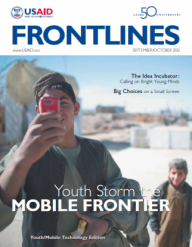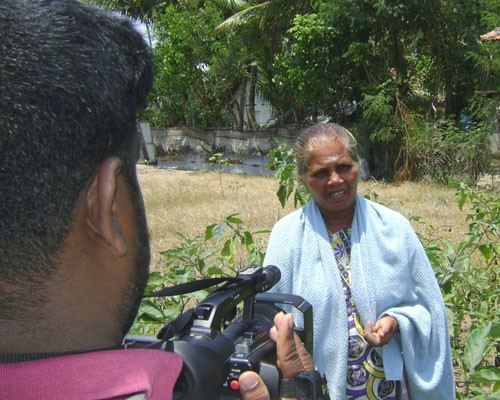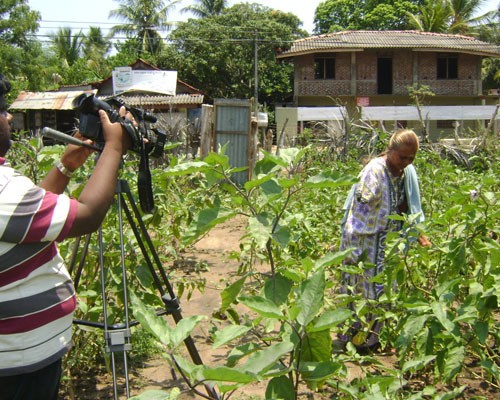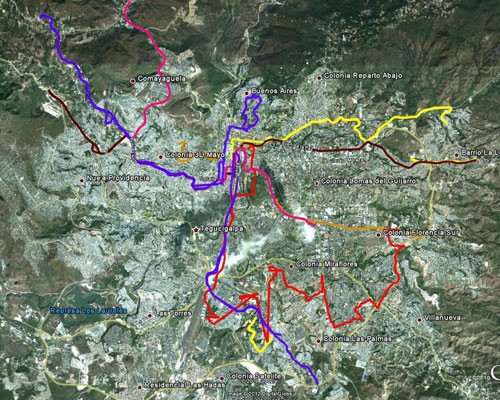 A group of St. Marc’s young mappers collect GPS data for OpenStreetMap.
CREDIT: USAID
A group of St. Marc’s young mappers collect GPS data for OpenStreetMap.
CREDIT: USAID
 A group of St. Marc’s young mappers collect GPS data for OpenStreetMap.
CREDIT: USAID
A group of St. Marc’s young mappers collect GPS data for OpenStreetMap.
CREDIT: USAID
Many developing countries are experiencing a potentially destabilizing demographic known as the “youth bulge.” However, technology is proving a tool to empower youth to be active participants in developing their country, to voice their opinions and ideas about economic growth, and to promote social stability. And while, for instance, Africa is predicted to double its population by 2050, and East Asia’s young labor force is producing remarkable economic growth, this “demographic dividend” is poised to potentially change the course of countries currently struggling with developmental challenges.
Throughout the world, USAID is working to link youth with technologies in innovative ways that promote peace and progress. The following stories demonstrate how the Agency fosters political opportunities for youth to become leaders in the 21st century.
Honduras: Youth Board the Buses to Map Violence
Honduras’ crime rate has made headlines in the past several years; the United Nations and the Honduras national police tallied 86 homicides per 100,000 people in 2011—the highest in the world. The public bus system in the country’s urban centers is particularly plagued with violence. Boarding a bus comes with the risk of confronting gang violence or armed robbery. Bus owners and drivers are frequent targets of extortion—and murder is often the reprisal if they resist. To compound the problem, there are no official schedule or route maps nor any documents that pinpoint zones of heavy violence.
This past June, 17 young Hondurans, armed with only a global positioning system (GPS) device the size of a business card, boarded the violence-ridden buses of Tegucigalpa to begin to unravel their transportation system and create public bus maps for citizens of the capital. Mapping and crowd-sourcing often result in both short-term and long-term gains. In the short term, citizens provide each other with crucial safety information. They can inform the police and make decisions to avoid becoming victims. In the long term, the activities can help increase public confidence and transform fearful citizens into active agents of reform.
During this one-week pilot exercise, USAID introduced community mapping concepts to members of the national anti-violence youth movement Movimiento Jovenes contra la Violencia. The Movimiento youth immediately volunteered to head the bus mapping activity, starting with 15 of the most frequented and violent bus routes in their city.
Based on feedback from the pilot, USAID learned that, with the right tools, citizens can create social maps that empower them to establish order in an environment fraught with crime and violence.
“The young people who volunteered for this pilot activity were extremely enthusiastic—they drafted their mapping plan with great care, balancing their own safety with what they felt the public needs to know,” said Andrew Wiseman, a member of USAID’s assessment team.
The route map will gradually be made public, in paper form and on the Internet. The project data will be linked to basic geo-spatial information and local violence data and trends to not only inform USAID activities in Honduras, but also to help Honduran bus drivers, riders and the police stay informed and alert.
Kyrgyz Republic: From Apathy to Election Watchdogs
The Kyrgyz Republic, the former Soviet republic on the northwest border of China, has recently undergone significant political and social upheaval, with youth often in the frontlines of conflict. In April 2010, escalating political protests and violence in northern Kyrgyz Republic led to the overthrow of President Kurmanbek Bakiyev. Two months later, tensions between Kyrgyz and Uzbek ethnic groups in Osh and Jalalabad oblasts escalated into violence that spread across the south and left hundreds dead and thousands displaced.
The country’s youth were active participants in the upheaval, and, today, disillusionment with politics and high unemployment rates continue to exacerbate tension between young citizens and their government. To help build a stronger, more democratic future, USAID is engaging youth in social media projects that tackle some of the country’s toughest issues and give them a voice in shaping their future.
In an effort to bring greater transparency to the October 2011 presidential election and promote positive participation in the electoral process, USAID partnered with a local group, Youth of Osh, to train 87 citizen observers on using SMS technology to monitor elections in more than 70 voting stations in Osh, Jalalabad and Batken in the country’s south. These young people reported potential election violations via text to a central clearinghouse, which posted the information on a U.S. Government - and United Nations Development Program-supported website made available to the public during the election period.
While the elections were peaceful, nearly 1,300 violations were reported via text in the south, which government officials then investigated. According to a prominent civil society representative, the project set an important precedent by showing the population that transparent elections were possible and violations could be tracked and reported.
The Government of the Kyrgyz Republic responded positively to the mapping tool, and staff from the Office of the Prosecutor General requested, and received, training from the NGO Civil Initiative on Internet Policy on how to use the site to monitor electoral violations. Following the election, the Central Elections Commission investigated many of the allegations and responded accordingly to violations.
The project increased access to reliable information and reduced the impact of rumors during the critical elections period, helping to build confidence in the elections process and reduce violence.
The project also provided a valuable opportunity for youth. Farida*, a youth observer from Batken oblast, said that the elections monitoring training played an instrumental role in helping her participate in the election process. It also taught her how to use valuable social media tools. “Now I feel confident and prepared for the coming election …. This will be my first experience in observing elections, and I will do all my best to contribute to the transparent and democratic elections,” she said.
Haiti: Putting a Post-Earthquake Refuge on the Map
Without a basic map of streets and key infrastructure, developing an urban area like St. Marc, Haiti, can be a major challenge. USAID partnered with Humanitarian OpenStreetMap Team (HOT) and Communaute OpenStreetMap Haiti (COSMHA) to solve this problem by engaging youth trained in basic community mapping skills. In only three months, the youth have made St. Marc the best mapped city in Haiti.
After an earthquake devastated much of Port-au-Prince in 2010, thousands of residents resettled in areas outside of the capital, including the nearby city of St. Marc. With the influx of new residents, urban planning and renewal became a key priority for local officials, community groups and international donors. And while Haiti has a long way to go to rebuild, USAID is supporting programs to promote long-term sustainable development.
In St. Marc, with support from HOT and COSMHA professionals and using only GPS devices and laptops, 30 local youth took to the streets to identify basic community infrastructure, key landmarks and public service facilities. This information is available not just to mappers throughout Haiti, but to the international community, Government of Haiti counterparts, entrepreneurs and citizens around the world via a free online map of the world that anyone with Internet access can use and improve.
The comprehensive data is also available in the form of large, color maps that have been printed and distributed throughout St. Marc to government offices and community groups. With a clear visual depiction of the St. Marc community, donors are better able to plan and deliver assistance, and government officials can better plan infrastructure projects and service delivery. For example, the Direction de la Protection Civile (DPC), the country’s primary disaster response agency, can now access the location and type of almost every structure in the affected areas. They can also work with local DPC committees to identify shelter locations and add them to the OpenStreetMap.
Additionally, the data provides a solid foundation to the local office of the Direction Générale des Impôts, Haiti’s tax agency. As the agency increases its capacity to process tax payments, knowing where businesses are located is critical in order to add them to the tax rolls.
“The [mapping activity] gave me a chance to collaborate with youth who are in other communal sections of the community,” said Pereste Caseus, a participating mapper. “I am proud to have done a mapping study, even a basic one, because it was a chance to be among the young pioneers … in St. Marc.”
Sri Lanka: Young Filmmakers Give Divided Country a Common Voice
In the wake of a decades-long civil war, a fragile peace has developed in Sri Lanka, though communities remain deeply divided. To help break down walls between regional, religious and ethnic communities, a USAID-funded project trained Sri Lankan youth to produce a series of human interest video documentaries focused on reconciliation, which were broadcast nationally. The project trained 18 young reporters from across the country in journalism, camera and audio equipment, and production and editing techniques to produce 45 stories. Working with Young Asia TV, the documentaries were produced for weekly national television broadcasts called “Development Diaries,” which portray issues and experiences in the north, south and east of Sri Lanka that are common to Sinhala, Muslim, Burgher and Tamil communities.
“Although Sri Lankans in different parts of the country had very different experiences throughout the civil conflict over the last 30 years, similarities were portrayed in order to promote peace and understanding,” said Thangavel Sakthivell, program development officer for the USAID program.
The 45 stories were broadcast in both Sinhala and Tamil languages with subtitles.
For most of the young people involved, this was the first opportunity to interact professionally with other communities.
“Even though we had language barriers at first, this training gave us a good opportunity to build relationships with youth from the south,” said Selvanathan Ramanan, 25, from Jaffna. The bonds formed by this group were evident through a simple gesture of kindness: When one of the reporters lost his cell phone, the rest of the group pooled their money to replace it. The project was so successful, that a second season of broadcasts is now being sponsored by USAID, building on lessons learned, improving representation of minority viewpoints in national media, and improving media coverage of post-war development issues.
*Last name withheld for privacy reasons.














Comment
Make a general inquiry or suggest an improvement.